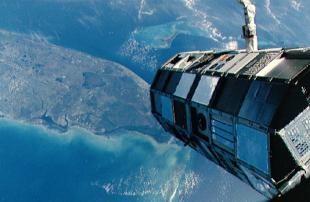STS-41-C
|
|
| Mission Insignia | |
|---|---|
| Missing image STS-41-C_patch-small.png image:STS-41-C_patch-small.png | |
| Mission Statistics | |
| Mission: | STS-41-C |
| Shuttle: | Challenger |
| Launch Pad: | 39-A |
| Launch: | April 6, 1984, 8:58:00 a.m. EST |
| Landing: | April 13, 1984, 5:38:07 a.m. PST, Edwards Air Force Base |
| Duration: | 6/23:40:07 |
| Orbit Altitude: | 313 nautical miles |
| Orbit Inclination: | 28.5 degrees |
| Miles Traveled: | 2,870,000 |
| Crew photo | |
| Missing image STS-41-C-crew-small.jpg image:STS-41-C-crew-small.jpg Photo of 41-C crew taken in aft flight deck of the Challenger while in orbit. Astronauts Robert L. Crippen, right, crew commander; and Francis R. (Dick) Scobee, left, pilot, flank the mission specialists -- (l-r) George D. Nelson, James D. van Hoften and Terry J. Hart. | |
STS-41-C was the 11th Space Shuttle mission and the fifth for Challenger. The launch was flawless and executed the first direct ascent trajectory for a Shuttle mission. The mission was extended one day due to problems capturing the Solar Max satellite, and the landing was at Edwards Air Force Base instead of Kennedy Space Center as planned.
| Contents |
Crew
- Robert Crippen (flew on STS-1, STS-7, STS-41-C & STS-41-G), Commander
- Francis R. Scobee (flew on STS-41-C & STS-51-L), Pilot
- George D. Nelson (flew on STS-41-C, STS-61-C & STS-26), Mission Specialist
- James D. A. van Hoften (flew on STS-41-C & STS-51-I), Mission Specialist
- Terry J. Hart (flew on STS-41-C), Mission Specialist
Mission Parameters
- Mass:
- Orbiter Liftoff: 115,361 kg
- Orbiter Landing: 89,344 kg
- Payload: 17,357 kg
- Perigee: 222 km
- Apogee: 468 km
- Inclination: 28.5°
- Period: 91.4 min
Space walks
- Nelson and van Hoften - EVA 1
- EVA 1 Start: April 8, 1984 - 14:18 UTC
- EVA 1 End: April 8, - 16:56
- Duration: 2 hours, 38 minutes
- Nelson and van Hoften - EVA 2
- EVA 2 Start: April 11, 1984 - 08:58 UTC
- EVA 2 End: April 11, 1984 - 15:42 UTC
- Duration: 6 hours, 44 minutes
Mission Highlights
In April 1984, Challenger was once again flying in space, this time on the STS 41-C mission. Liftoff took place at 8:58 a.m. EDT, on April 6, 1984. It marked the first direct ascent trajectory for the Shuttle which reached its 288-mile-high orbit using the Orbiter Maneuvering System engines only once -- to circularize its orbit.
The flight had two primary objectives. The first was to deploy the huge Long Duration Exposure Facility (LDEF), a passive, retrievable, 21,300-lb., 12-sided cylinder, 14 feet in diameter and 30 feet long carrying 57 experiments. The second objective was to capture, repair and redeploy the malfunctioning Solar Maximum Mission satellite -- "Solar Max" -- launched in 1980.
The five-man crew included Robert L. Crippen, commander, on his third Shuttle flight; pilot Francis R. Scobee; and mission specialists, James D. van Hoften, Terry J. Hart and George D. Nelson.
On the second day of the flight, the LDEF was grappled by the RMS arm and successfully released into orbit. Its 57 experiments, mounted in 86 removable trays were contributed by 200 researchers from eight countries. Retrieval of the passive LDEF had been scheduled during 1985, but schedule delays and the Challenger accident have postponed the retrieval effort.
On the third day of the mission, Challenger's orbit was raised to about 300 miles, and it maneuvered to within 200 feet of Solar Max. Astronauts Nelson and van Hoften, wearing space suits, entered the payload bay. Nelson, using the MMU, flew out to the satellite and attempted to grasp it with a special capture tool called the Trunnion Pin Acquisition Device (TPAD). Three attempts to clamp the TPAD onto the satellite failed. It began tumbling when van Hoften attempted to grasp it with the RMS arm, and the effort was called off.
During the night, the Solar Max POCC, at Goddard Space Flight Center, Greenbelt, Md., was able to establish control over the satellite by sending commands ordering the magnetic torque bars to stabilize the tumbling action. This was successful and the Solar Max went into a slow, regular spin.
The next day, Nelson and van Hoften tried to capture it again. This time they succeeded on the first try. They placed Solar Max on a special cradle in the payload bay using the RMS. They then began the repair operation, replacing the satellite's attitude control mechanism and the main electronics system of the coronagraph instrument. The ultimately successful repair effort took two separate space walks. Solar Max was deployed back into orbit the next day, thus concluding one of the most unique rescue and repair missions in the history of the space program.
After a 30-day checkout by the Goddard POCC, Solar Max resumed full operation.
Other STS 41-C mission activities included a student experiment located; in a middeck locker to determine how honeybees make honeycomb cells in a microgravity environment. They did so successfully, just as on Earth.
The 6-day, 23-hour, 40-minute, 7-second mission ended on April 13, at 5:38 a.m. PST, with Challenger landing on Runway 17, at Edwards AFB. It had completed 108 orbits and traveled 2.87 million miles. Challenger was returned to KSC on April 18.
Related articles
- Space science
- Space shuttle
- List of space shuttle missions
- List of human spaceflights chronologically

The Long Duration Exposure Facility (LDEF) is placed in orbit by the shuttle Challenger crew in this view. Still attached to the Remote Manipulator System (RMS) end effector, the LDEF is backdropped against Florida, the Bahama Bank, the Gulf of Mexico and Atlantic waters.
External links
- NASA mission summary (http://science.ksc.nasa.gov/shuttle/missions/41-c/mission-41-c.html)
- The Dream is Alive (http://us.imdb.com/title/tt0089050/) IMAX film with footage from STS-41-C
| Previous Mission: STS-41-B |
Space Shuttle program | Next Mission: STS-41-D |
